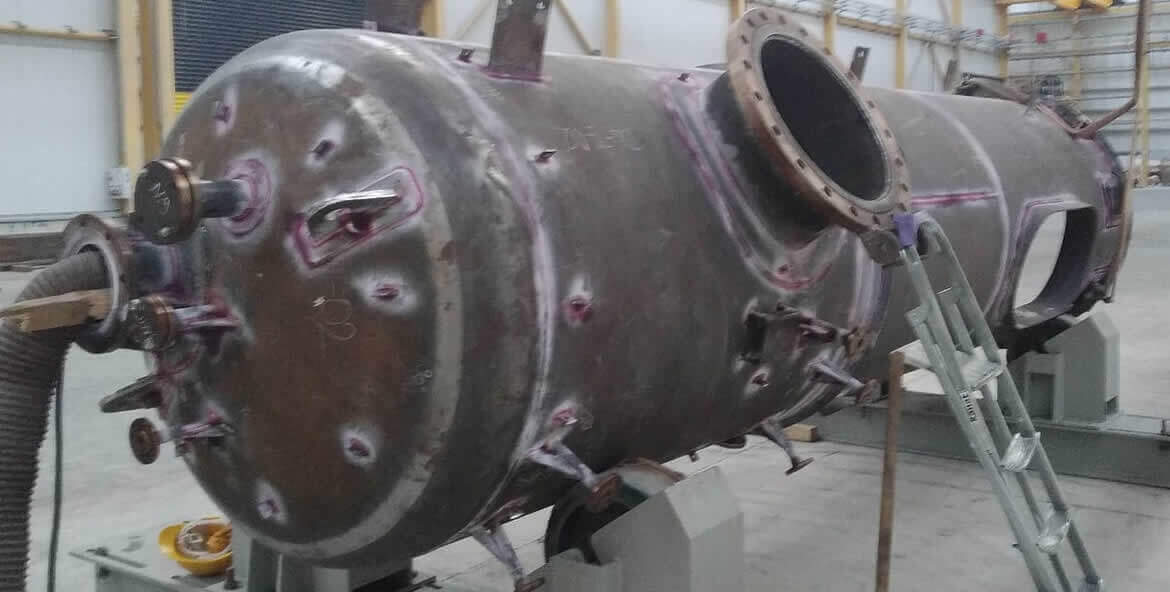Pressure vessel manufacturing
The pressure vessel manufacturing process begins with the design phase. Our design engineers consider factors such as operating pressure, temperature, and material properties to design a vessel that meets the specific requirements of the application.
- Home
- Our-services
- Pressure vessel manufacturing
Our manufacturing services
- Pressure vessel manufacturing
- Atmospheric tank manufacturing
- Heat exchanger manufacturing
- Conveyor belt manufacturing
- Bucket elevator manufacturing
- Storage tank manufacturing
- Chain conveyor manufacturing
- Vibrating screen manufacturing
- Tumbler screen manufacturing
- Gas scrubber tower manufacturing
- Cooling tower manufacturing
- Industrial filter manufacturing
- Ball mill manufacturing
- Crusher manufacturing
- Cooling drum manufacturing
- Drying drum manufacturing
- Reinforced concrete manufacturing
- Steel construction manufacturing
Promotional brochure
Download our catalogue to see specific data about the service we provide and how we work.
Stay in touch!
Please feel free to contact us. We will get back to you within 1-2 business days. Or call us now.
Pressure vessel manufacturing
During the fabrication process, skilled welders use a variety of welding techniques to join the components of the vessel. Welding is a critical aspect of pressure vessel fabrication, as any flaws or imperfections in the welds can compromise the integrity of the vessel. Welders must be trained in the proper techniques and procedures for welding pressure vessel materials to ensure a strong, reliable weld.
Quality control is an important part of the pressure vessel manufacturing process. Inspections and tests are performed at various stages of production to ensure that the vessel meets the required standards and specifications. Non-destructive testing methods, such as radiographic testing and ultrasonic testing, are used to detect any flaws or discontinuities in the welds or materials of the vessel.
When the mixed gas enters the system from the middle section of the washing tower, the liquid product component between the trays and the vaporized part of the product component gas simultaneously liquefies. However, impurities do not become liquid or solidify. As the gas passes through the liquid component trays, the liquid product component is fixed and thus an effective washing effect occurs. The design and production of the washing tower was carried out based on this principle.
Pressure vessel manufacturing process
Pressure vessels are containers designed to hold liquids or gases at a pressure different from the ambient pressure. These containers are used in many industries such as petrochemical, oil and gas, pharmaceutical, food and beverage, and energy production. Pressure vessels are preferred for the storage and transportation of various substances such as liquids, gases, and even solids.
Types of pressure vessels
Pressure vessels come in different varieties designed to handle a specific substance or type of pressure. Here are some of the most common types of pressure vessels:
Boilers: Made of alloy steel to withstand high pressures and temperatures. Their primary function is to produce hot water or steam, which can then be used as a power source for different processes.
Storage Tanks: Used to store liquids or gases, these vessels are often used to store crude oil, natural gas, and other energy sources, especially in the oil and gas sector.
Separators: Designed to separate substances such as oil, gas, and water, these vessels play an important role in the oil and gas industry in separating different components of the flow coming from wells.
Distillation Columns: Used to separate components of mixtures based on their boiling points, these structures are widely used in the chemical and petrochemical fields.
Reactors: Reactors used to carry out chemical reactions are designed to tolerate high temperatures and pressures. They may contain components such as mixers, deflectors, or coils in their internal structure.
Heat Exchangers: These vessels are used to transfer heat from one fluid to another and generally play an active role in HVAC systems, cooling processes and various chemical processes.
Areas of use of pressure vessels
Oil and Gas Industry: Pressure vessels are widely used in the petroleum industry, which includes onshore and offshore operations. In this industry, pressure tanks often serve as receivers under high temperature and pressure conditions.
Chemical Industry: Some pressure vessels commonly used in chemical refining processes include columns, boilers, separators, knockout drums, towers, and shell tanks.
Energy Industry: Pressure vessels are used in the power generation sector to store polluted gases.
Frequently asked questions
Industrial equipment is the backbone of a variety of industries, increasing operational efficiency and productivity while supporting quality control. But to do this, such equipment must be reliable, efficient and durable. It all starts with the assembly of high-quality parts.
Experience is key when choosing an equipment provider. Be wary of startups that promise big results but lack the insight and scalability that comes with experience. Our company has been in the industry for over 25 years with 100% equity.
Our company has experience in sulfuric acid plant equipment, phosphoric acid plant equipment, fertilizer factory equipment, ammonia factory equipment, cement factory equipment, sugar factory equipment, oil factory equipment, thermal power plant equipment manufacturing, hydroelectric power plant equipment manufacturing, pharmaceutical factory equipment manufacturing, feed factory equipment manufacturing, chemical factory equipment manufacturing, all types of industrial facility construction and all types of structural steel manufacturing, and we adapt more environmentally friendly and sustainable technologies to our engineering solutions.
In addition to Carbon steel and Stainless steel equipment, we design and manufacture process equipment with different metallurgies such as Hastelloy, Alloy20 and Incoloy.
Although CNC machining is a precision manufacturing method, our local and international quality control procedures ensure that your finished part is to specification and adheres to specified tolerances.
Delivery time varies depending on the type and quantity of equipment or machinery, and usually ranges from weeks to months.


